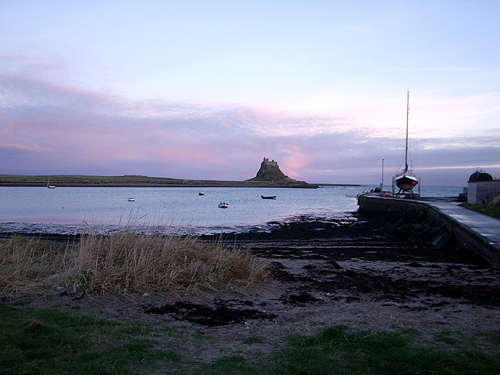Spirit of Place is an on-going body of work and is an exploration of Lindisfarne, a unique and distinctive island off the coast of Northumberland, cherished in folk tales, festivals and celebrations. The Celts called places such as Lindisfarne 'thin places', where the boundary between heaven and earth is especially thin. Where we can sense the divine more readily and we can absorb the invisible weave of culture (stories, art, memories, beliefs, histories, etc.).
I've been visiting Lindisfarne since I was a very small child and more latterly as an adult over the last twenty years. Sensing the wild landscape and beauty of this sanctuary of creation has helped me to create work in response to my just being there in the tangible physical aspects of the island and a sense of the other. The island was an important centre for Celtic Christianity under Aidan, Cuthbert, Eadfrith and Eadberht. It is where the Lindisfarne Gospels were created in the 7th century. This work is an attempt to capture the mystery and spirit of place through paintings, photographs and poetry over two decades.
The Singing Bowl from Rhonda Fenwick on Vimeo.
Saudades
(the title of this poem is taken from a Portuguese word meaning "feeling the presence of an absence" inspired by a visit to Lindisfarne Castle 25/5/07. I wandered through the castle as a cellist played a classical piece on the cello left in the music room in remembrance of the Portuguese cellist Guilhermina Suggia)

To the little girl with tear drop eyes,
taken from her bed of sorrows,
your absent presence felt
without a word spoken,
dull, grey speech sprawled out
moving towards an upturned boat,
all at sea, no movement as waves
crash against the pebbled beach;
no news today of you from your
red petalled lips, only glass reflections
in a square round box,
lights, sounds, equivalents in time,
passing echoes, to small to surrender
your hopes, dreams ad wishes,
clouds dash by pushed by winds of change;
the deaf and dumb sign black statements,
as a quill pen splashed ink on a
stone white floor, an order of silence
deafens the room, garbled messages
as the stars plummet to their darkness,
with no strings attached to the cold moon,
in mourning, will we see you again?
Lindisfarne March 2011 from Rhonda Fenwick on Vimeo.
The interactions with people we meet as we travel through life can leave traces of memory, ideas and imaginings. We can develop a sense of place through these experiences and knowledge of landscape and history after living there for a time.
The feel of the sun on your face or the rain on your back, the rough and smooth textures of the land, the colour of the sky at morning and sunset, the fragrance of the plants blooming in season, the songs and antics of birds and the cautious ramblings of mammals are environmental influences that help to define a place. Memories of personal and cultural experiences over time make a place special, favourite objects that shape to your hand or body with use, songs or dances that emerge from the people of a place, special skills you develop to enjoy your area — these too help to define a place and anchor you in it. Through time, shared experiences and stories (history) help to connect place and people and to transmit feelings of place from generation to generation.
This definition is complex and multi-faceted much like true Places are, blending the physical characteristics of the land with memory, art, story, and the inexplicable feel that Places leave on the skin and mind.
Art making is a way in which to understand myself and the world around me especially in these times of destruction and violence. I believe in art, spirit, culture and truth in the world. This is the life force that enables us to be here in the now.